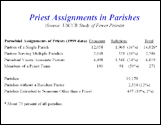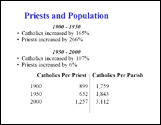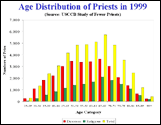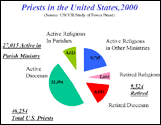You are here ![]() Home >> Step Two: Set up a dialogue >> A Changing Way of Life for Priests
Home >> Step Two: Set up a dialogue >> A Changing Way of Life for Priests
A Changing Way of Life for Priests
On the one hand, the core role of the priest is clear and never-changing. On the other, there has been a dramatic change in what priests do and in the presence of priests within the Catholic Church in the United States.
Think about a priest in 1950 and think about one today. In 1950 there were 652 Catholics per priest, most of whom were in active ministry. By 2000, there were 1,257 Catholics per priest, and nearly a third of all priests are retired or over the age of 70.
Today, priests collaborate in ministry with a wide variety of specialized lay ecclesial ministers and deacons who serve as Directors of Religious Education, youth ministers, pastoral associates, and many other roles.
Of the more than 19,000 Catholic parishes in the United States, a little more than 4,000 have more than one priest. On the other hand, over 2,000 parishes have a pastor who simultaneously pastors another parish. Another 8,000 parishes are served by a single priest-pastor who pastors no other parish.
Priests live in their parish communities—typically the same building where parish offices are located, "above the store" so to speak, often with a minimum of privacy. Almost all diocesan priests in active parish ministry are on call 24 hours a day—more than 90 percent, according to one recent survey of priests conducted by CARA, the Center for Applied Research in the Apostolate at Georgetown University.
From 1970 to the present, the total number of priests fell by 20,000, or one-third of the total number of priests in 1970. Yet priests' dedication to their people has dramatically cushioned this remarkable reduction in numbers. As a result, almost all Catholics say they are aware that there are fewer priests, but only one in four report that this has affected them (CARA Catholic Poll 2000).
Like Protestant seminarians, Catholic seminarians are now spread across the entire age range. More than a third of seminarians are over the age of 35. Combined with fewer vocations to priesthood in general, this means that there are now dramatically fewer priests under the age of 35. In 1965, one in five of all active diocesan priests were under 35. By 2000, fewer than one in twenty active diocesan priests were under 35. Priests are older today and there are simply fewer priests to whom they can turn for assistance and support.
Today, more than any time in the past generation, priests who serve a diocese are a mini United Nations. About 20 percent of them were born outside the United States, not merely outside the diocese in which they minister. When priests get together today, they need to be sensitive to the different accents and different food preferences of their brother priests as well as the different kinds of parish communities and ministry challenges they experience. Cultivating unity within the priests of a diocese is much harder today than in years past.
In spite of all these challenges, priests are not merely satisfied in their
ministry; they report being highly satisfied. Only a handful of priests say they
would not become a priest if they had it to do all over again. In a survey
conducted for the Los Angeles Times, just 7 percent of all priests who were
polled felt this way.
Discussion Slides:
[ click thumbnails to enlarge ]
Today, most diocesan priests live alone. Immigrant priests or others on loan who serve the Eastern Catholic Churches in the United States may be married, and it is commonly said that there are about 75 married priests within the Latin Rite. These are former ministers or priests from other Christian traditions who were accepted for priestly ordination by the Catholic Church.
In conclusion, there are many fewer priests today, particularly if we subtract out retired priests. And yet Mass is celebrated, parish life is attended to, and many Catholics would hardly know that there are significantly fewer priests. Why? The answer has to do with priests themselves. They have responded generously to the call to serve the People of God, often at great personal cost, and with limited acknowledgement or appreciation by the people they serve, whether bishops or parishioners. They continue to work to lift up and serve the People of God through the power of the sacraments and the joy of helping people connect with the sacred in their ordinary, everyday lives.
The sheer giving nature of priests. It's something to celebrate. It's something for which we need to thank God. It's something for which we need to thank priests.
Center for Applied Research in the Apostolate
Frequently Requested Catholic Church Statistics
CARA gets many inquiries from Church agencies and the media about the numbers for vocations, seminary enrollments, priests and vowed religious, parishes, Mass attendance, schools and the Catholic population. Please visit CARA for additional and updated information related to Church statistics.
http://cara.georgetown.edu/bulletin/index.htm
The Catholic Church in the United States At A Glance
The Office of Media Relations represents the Catholic Bishops of the United
States to the media and the media to the bishops. The office's responsibilities include
preparing and distributing statements and other resources for the media,
arranging for interviews with bishops and staff of the USCCB, organizing press
conferences, responding to media queries and credentialing media for coverage of
such events as the bishops’ annual meetings. Please visit the USCCB for
additional and updated information related to the US Catholic Church.
http://www.usccb.org/comm/mr_usachurch.shtml
![]()
Pray! Invite! Encourage! Affirm! Vocations
Text & Design © 1997-2015 All rights reserved. | Last Modified:August 09, 2016 |
USA Council of Serra International
333 W Wacker Dr Suite 500 · Chicago IL 60606 · Phone (312) 201-6549 · Fax (312) 201-6548





